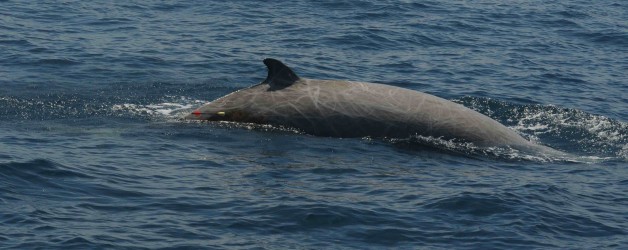Last week we welcomed Jessica Aschettino to our field team to deploy satellite-linked dive recorders for the second phase of the 2018 Behavioral Response Study, funded by NAVFAC Atlantic (U.S. Navy). Daniel Webster, who usually deploys satellite tags for us, injured his hand and was unavailable. Jessica, who works for HDR in Virginia Beach, kindly agreed to pitch hit at the last minute and we are very grateful for her efforts and companionship in the field. And, it turns out, that Jessica is a steely-eyed beaked whale tagger.

Breaching Ziphius off Cape Hatteras
We were very fortunate, not just to be able to work with Jessica, but also because of the amazing confluence of perfect weather conditions and a very high density of co-operative beaked whales in the amazingly clear blue waters of the Gulf Stream.

Ziphius surfacing in the Gulf Stream 40 miles off Cape Hatteras
In three glassy, hot days on the water, we tagged 10 Cuvier’s beaked whales and four short-finned pilot whales. I don’t think anyone keeps a record book, but if such a thing existed, I think we would be at the very top in terms of the number of beaked whales tagged in such a short period.

Tusks erupted at the distal tip of the lower jaw in an adult male Ziphius
We also saw some old friends from past field seasons and collected four biopsy samples from Cuvier’s beaked whales. Heather Foley proved particularly adept, collecting two samples at distances well over 30 m. We’re fortunate to have such highly skilled field scientists in our lab.

Biopsy dart en route to sample a tagged Ziphius off Cape Hatteras.
Our success this week underscores the special nature of our field site. The deep waters off the Point at Cape Hatteras hold one of the highest densities of Cuvier’s beaked whales in the world and, when the weather conditions are right, we can conduct a spectacular amount of work in a very short period.

Scars on a male Ziphius from past encounters with other males.
We continue to be amazed and intrigued by the beaked whales we study. Adult males bear the scars of past interactions with other males – two tusks erupt from the tip of the lower jaw in older males – but we never see any social interactions in the very brief time they spend at the surface. Do they interact during their relatively short (20-minute) bounce dives or during the longer (60-minute plus) foraging dives at great depths?

Crew of the RV Barber 40 miles off Cape Hatteras. Photo by Will Cioffi.
Now we have so many tags deployed, our attention will turn to conducting Controlled Exposure Experiments with tactical mid-frequency sonars, either with a specially designed underwater sound source, or with real Navy vessels. Stay tuned.

